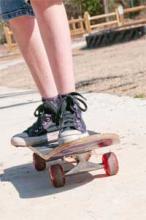
Equilibrium is the state of balance acquired when contending forces are equal.1 The “sense of equilibrium” involves having a sense of security when standing, walking, or performing any movement.2 A number of factors are involved in equilibrium of the body, including visual cues, tactile kinesthetic sensations, and vestibular (inner ear) stimulation.3
Visual orientation references, such as a rigid flat floor and fixed vertical walls, allow the eyes to calculate space in a normal manner to aid equilibrium. When moving objects or uneven surfaces are introduced in the visual field, these cues must be overcome or disorientation and instability may result.4
When walking or running, tactile senses, sent through the nervous system to the brain from the soles of the feet and from the muscles of the limbs and trunk to the brain, guide the muscular movements to make the next step.5 This unconscious perception of movement and spatial orientation aided by sensory information sent from the nervous system is called proprioception.6 If there is impairment in receiving or transmitting these senses, there will be difficulties in maintaining equilibrium.
Two fluid-filled sacs in the inner ear register changes in gravity, position, and orientation that affect equilibrium.7 A vestibular disorder can produce the feeling of unbalance and may give the sensation of falling or leaning to one side.8 When the inner ear senses motion, but the eyes don’t see it, it sends conflicting messages to the brain, which disrupts equilibrium and can cause nausea and a dizzy feeling. Motion sickness is a common problem experienced when traveling in any moving vehicle.9
Children, who play on swings and climb ladders and monkey bars at the playground, need to have good balance, equilibrium, and coordination. Merry-go-rounds and other moving elements can affect a child’s equilibrium. Today’s playground manufacturers are developing new playgrounds with innovative structures that incorporate motion. They are designed to improve agility, balance, equilibrium, and coordination as children navigate moving walkways, spinning equipment, uneven surfaces, and climbing nets and rock walls.
- 1. “Equilibrium.” The American Institute of Balance. < http://dizzy.com/dizzines_and_equilibrium.htm#glossary > 4 Aug. 2010.
- 2. “Equilibrium.” Love to Know 1911. Classic Encyclopedia. < http://www.1911encyclopedia.org/Equilibrium > 4 Aug. 2010.
- 3. Frost, Joe L., Pei-San Brown, John A. Sutterby, Candra D. Thornton. The Developmental Benefits of Playgrounds. Olney, MD: Association for Childhood Education International, 2004. p. 130.
- 4. “Balance Control” NeuroCom International, Inc. < http://www.resourcesonbalance.com/clinical_info/BalanceControl.aspx > 4 Aug. 2010.
- 5. Op. cit., Love to Know 1911.
- 6. “Proprioception” Answers.com. < http://www.answers.com/topic/proprioception > 4 Aug. 2010.
- 7. Ibid.
- 8. “Dizziness” The American Institute of Balance. < http://dizzy.com/dizzines_and_equilibrium.htm#glossary > 4 Aug. 2010.
- 9. “Motion Sickness” MedlinePlus. < http://www.nlm.nih.gov/medlineplus/motionsickness.html > 4 Aug. 2010.

